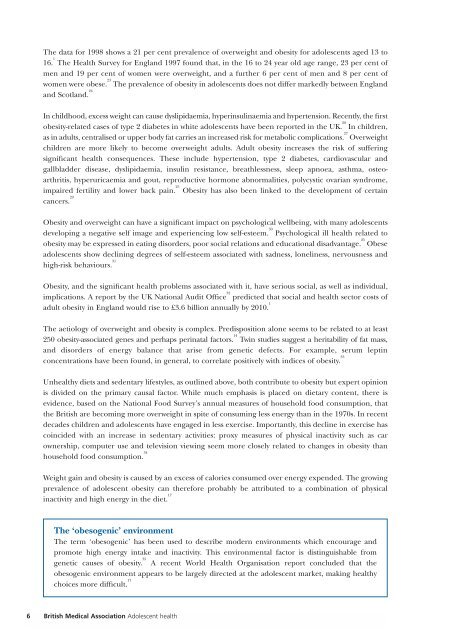Alcohol misuse: tackling the UK epidemic - London
Alcohol misuse: tackling the UK epidemic - London
Alcohol misuse: tackling the UK epidemic - London
You also want an ePaper? Increase the reach of your titles
YUMPU automatically turns print PDFs into web optimized ePapers that Google loves.
6<br />
The data for 1998 shows a 21 per cent prevalence of overweight and obesity for adolescents aged 13 to<br />
16. 1<br />
The Health Survey for England 1997 found that, in <strong>the</strong> 16 to 24 year old age range, 23 per cent of<br />
men and 19 per cent of women were overweight, and a fur<strong>the</strong>r 6 per cent of men and 8 per cent of<br />
women were obese. 23<br />
The prevalence of obesity in adolescents does not differ markedly between England<br />
and Scotland. 24<br />
In childhood, excess weight can cause dyslipidaemia, hyperinsulinaemia and hypertension. Recently, <strong>the</strong> first<br />
obesity-related cases of type 2 diabetes in white adolescents have been reported in <strong>the</strong> <strong>UK</strong>. 28<br />
In children,<br />
as in adults, centralised or upper body fat carries an increased risk for metabolic complications. 27<br />
Overweight<br />
children are more likely to become overweight adults. Adult obesity increases <strong>the</strong> risk of suffering<br />
significant health consequences. These include hypertension, type 2 diabetes, cardiovascular and<br />
gallbladder disease, dyslipidaemia, insulin resistance, breathlessness, sleep apnoea, asthma, osteoarthritis,<br />
hyperuricaemia and gout, reproductive hormone abnormalities, polycystic ovarian syndrome,<br />
impaired fertility and lower back pain. 25<br />
Obesity has also been linked to <strong>the</strong> development of certain<br />
cancers. 29<br />
Obesity and overweight can have a significant impact on psychological wellbeing, with many adolescents<br />
developing a negative self image and experiencing low self-esteem. 30<br />
Psychological ill health related to<br />
obesity may be expressed in eating disorders, poor social relations and educational disadvantage. 25<br />
Obese<br />
adolescents show declining degrees of self-esteem associated with sadness, loneliness, nervousness and<br />
high-risk behaviours. 31<br />
Obesity, and <strong>the</strong> significant health problems associated with it, have serious social, as well as individual,<br />
implications. A report by <strong>the</strong> <strong>UK</strong> National Audit Office 32<br />
predicted that social and health sector costs of<br />
adult obesity in England would rise to £3.6 billion annually by 2010. 1<br />
The aetiology of overweight and obesity is complex. Predisposition alone seems to be related to at least<br />
250 obesity-associated genes and perhaps perinatal factors. 14<br />
Twin studies suggest a heritability of fat mass,<br />
and disorders of energy balance that arise from genetic defects. For example, serum leptin<br />
concentrations have been found, in general, to correlate positively with indices of obesity. 33<br />
Unhealthy diets and sedentary lifestyles, as outlined above, both contribute to obesity but expert opinion<br />
is divided on <strong>the</strong> primary causal factor. While much emphasis is placed on dietary content, <strong>the</strong>re is<br />
evidence, based on <strong>the</strong> National Food Survey’s annual measures of household food consumption, that<br />
<strong>the</strong> British are becoming more overweight in spite of consuming less energy than in <strong>the</strong> 1970s. In recent<br />
decades children and adolescents have engaged in less exercise. Importantly, this decline in exercise has<br />
coincided with an increase in sedentary activities: proxy measures of physical inactivity such as car<br />
ownership, computer use and television viewing seem more closely related to changes in obesity than<br />
household food consumption. 34<br />
Weight gain and obesity is caused by an excess of calories consumed over energy expended. The growing<br />
prevalence of adolescent obesity can <strong>the</strong>refore probably be attributed to a combination of physical<br />
inactivity and high energy in <strong>the</strong> diet. 17<br />
The ‘obesogenic’ environment<br />
The term ‘obesogenic’ has been used to describe modern environments which encourage and<br />
promote high energy intake and inactivity. This environmental factor is distinguishable from<br />
genetic causes of obesity. 35<br />
A recent World Health Organisation report concluded that <strong>the</strong><br />
obesogenic environment appears to be largely directed at <strong>the</strong> adolescent market, making healthy<br />
choices more difficult. 17<br />
British Medical Association Adolescent health
















